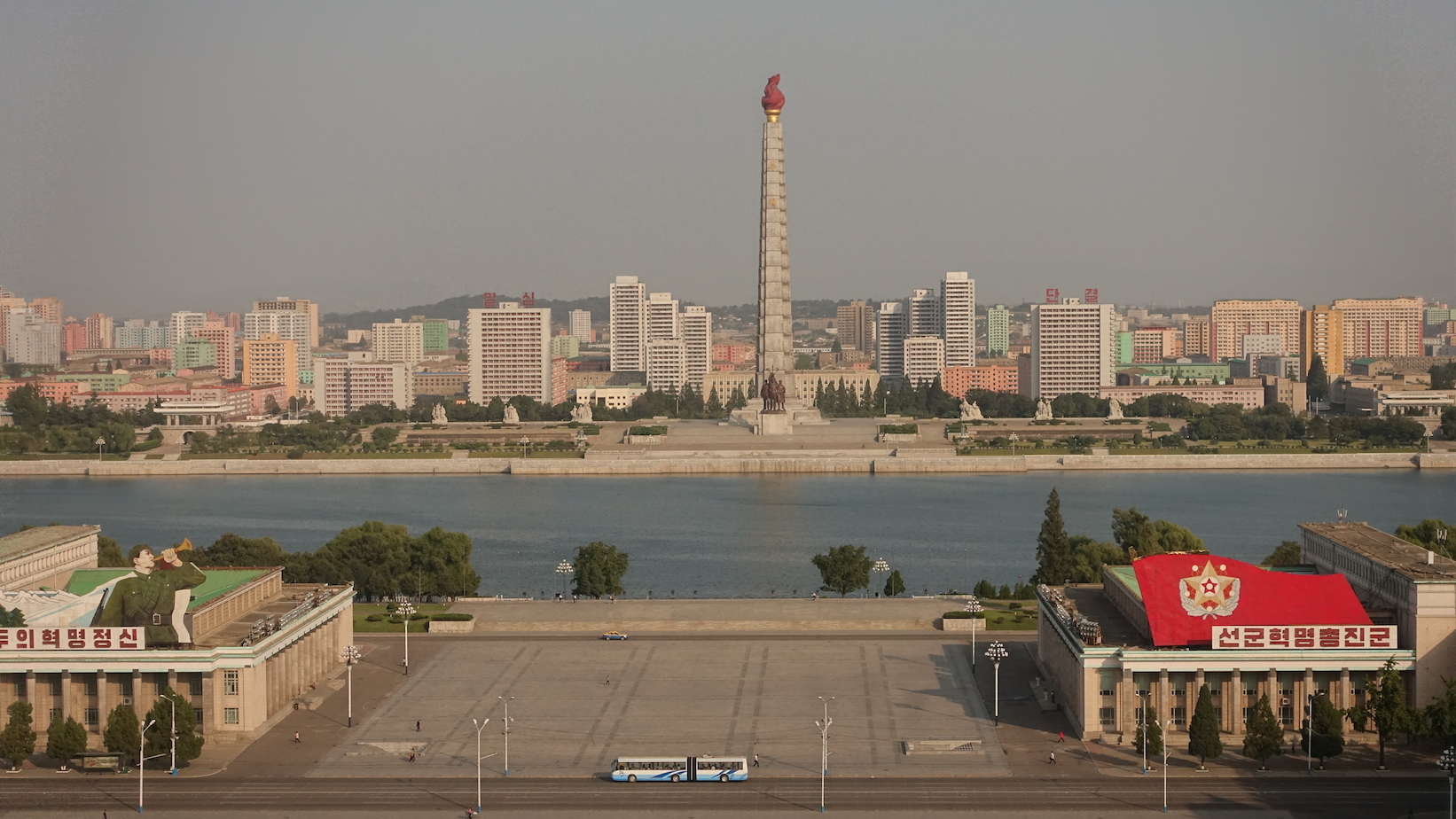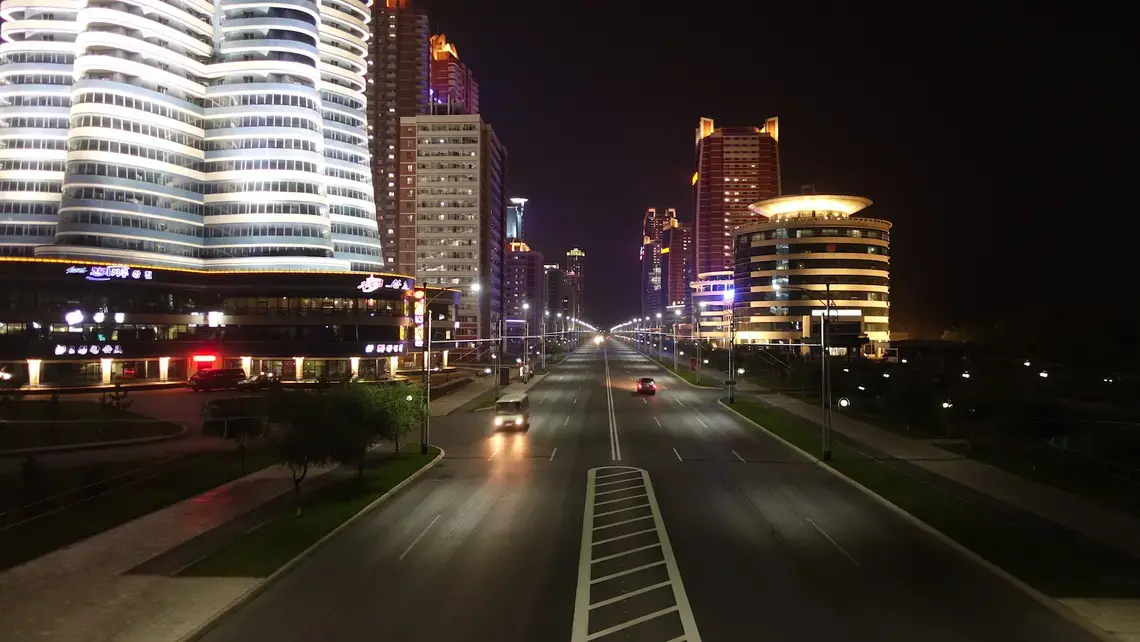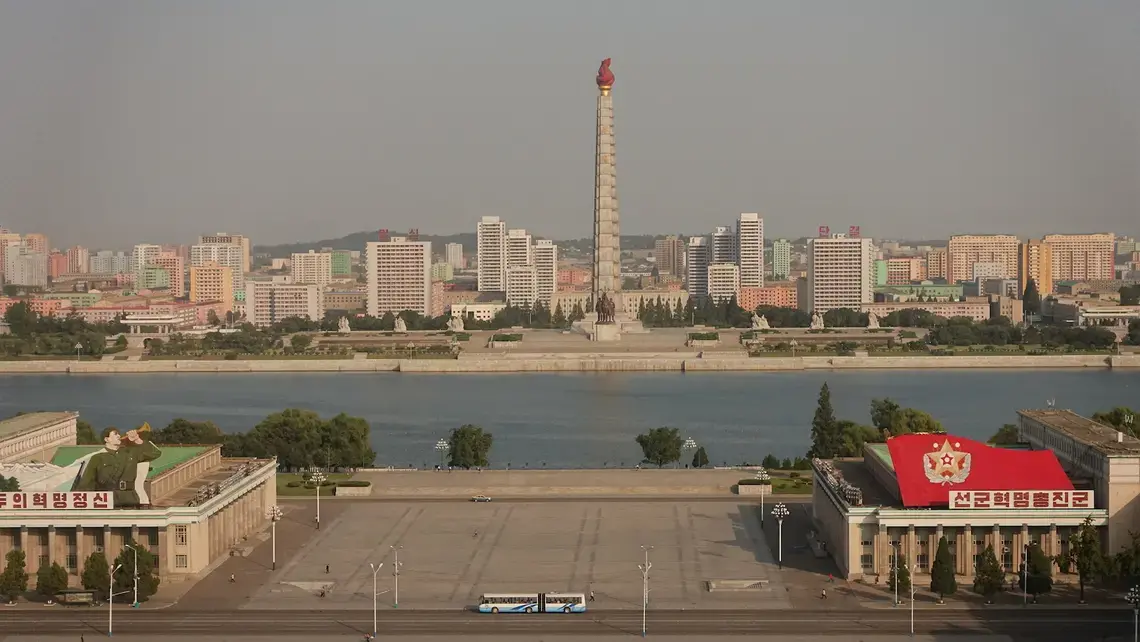PYONGYANG, North Korea — Towering apartment blocks line the gleaming, six-lane avenue known as Future Scientists Street, their boldly colored facades leaping from the drab hues that dominate the rest of Pyongyang's skyline.
At street level, there are electronics stores, a movie theater and a new pizzeria, where visitors are welcomed by young waitresses in bright red uniforms.
A pizza costs about $8, and a pasta entree less than half that. There is a bright aquarium near the entrance, but it is devoid of life — much like the restaurant, which was eerily quiet the night I visited.
The restaurant is Italy Pizza, hailed by local guides as the hottest new eatery in Pyongyang, the North Korean capital. It serves up a taste of cosmopolitan savvy for the city's elite — and proof to foreign visitors that all is well in the nation despite punishing economic sanctions, international isolation, and intermittent reports of deprivation and famine.
There is no doubt North Korea is racked with poverty. Its economy barely functions, and per capita gross domestic product is estimated as low as $1,800 per year. But for the privileged few in this city of three million — state officials and members of a nascent merchant class — options for entertainment have expanded since Kim Jong-un took power five years ago.
There are cafes and bars, tennis courts and gyms. There is a bowling alley and a fancy supermarket, a new dolphinarium and a water park. A half-hour's drive from downtown Pyongyang, the Mirim Riding Club boasts 120 horses — including Orlov Trotters sent as a gift by Russia's president, Vladimir V. Putin — and charges $8 to ride them for an hour outdoors, $10 indoors.
(Foreign visitors are generally first taken to the Revolutionary Site Education Room, a gallery that includes a giant photograph of Mr. Kim at age 4, in a pink cap and red mittens, playing with a horse. "Our Grand Marshal Kim Jong-un always possessed a special gift with animals," a guide told me.)
The North Korean government strictly controls what foreigners can see, so it is difficult to know to what extent Pyongyang's new urban amenities are real or how many people can enjoy them. But during a recent weeklong visit to attend a biennial film festival staged by the government, I was allowed to visit a few of the new venues, in the company of two official minders.
At the Rungna Dolphinarium, part of a larger amusement park on an island in the Taedong River, I joined an audience of more than 1,400 people who cheered as they watched spotted dolphins swim on their backs and jump through hoops.
After the show, I tried to take a photograph of the performance area, but a guide assigned to me by the dolphinarium grabbed the camera and deleted the picture. "You can see the workers cleaning the stage, and they are not dressed smartly enough," she said before walking off.
Later, I was taken to the Munsu Water Park, where families basked in sunny weather and children frolicked in pools that generate artificial waves. The staff members, dressed in svelte aquamarine uniforms, said about 5,000 people come every day, paying a 25-cent entrance fee and about $2.50 for every hour they spend in the facility's 26 pools.
One of the park's hosts eagerly noted that Mr. Kim had inspected the park while it was under construction to offer on-the-spot guidance. "The grand marshal insisted the park be managed for the people's convenience," she said with a smile.
It is a sore point for the North that its economy is so far behind that of South Korea, its neighbor and archenemy, and the government has tried to keep its chin up despite crippling sanctions imposed over its human rights abuses and nuclear weapons program.
Last week, the United Nations Security Council called on members to "redouble their sanction efforts" after North Korea defied warnings in September and conducted another nuclear test, its fifth and most powerful to date. On Monday, an official in Pyongyang dismissed the threat, saying "it is a complete miscalculation to think that any sanctions or pressure can have any effect on us."
North Korea tentatively began introducing market forces into its economy more than a decade ago, but experts say the push appears to have accelerated since Mr. Kim, believed to be 32, succeeded his father in 2011.
For the youngest scion of the Kim dynasty, introducing new amenities for the public is a way of highlighting the country's development under his rule and distinguishing himself from his predecessors, while also catering to an elite that is a key constituency for the regime.
"Pyongyang's leisure infrastructures are populated by a mélange of the traditional higher echelons of party and military, along with newer entrepreneurial social sectors, not of course forgetting their offspring," said Robert Winstanley-Chesters, who studies North Korean leisure spaces at Australian National University.
Some observers estimate that as much as 15 percent of Pyongyang's population are members of the privileged class described by Mr. Winstanley-Chesters.
"The best way to make money is to work for a large state company and demonstrate your capability and worth," said Andray Abrahamian of Choson Exchange, which conducts entrepreneurship workshops in North Korea. "Demonstrating you can run or help run a spinoff subsidiary on your own is even better."
Such subsidiaries include real estate developments and projects in a limited number of special economic zones, as well as restaurants.
My group of visitors had invited our minders and translators for a meal at Italy Pizza, and I sat next to a young man who identified himself, in fluent English, as a lecturer at the Pyongyang University of Foreign Languages. He told me he had been intrigued by pizzas ever since seeing them in English-language movies as a student.
"Even better than I expected!" he exclaimed, beaming, after his first bite of a margherita slice.
As we dined, a karaoke machine projected a slide show on a big screen with just two images, the name of the ruling Workers' Party and "1950-1953," the years of the Korean War, both set against a background of the party seal. No one got up to sing.
"There is an increasing demand among residents of Pyongyang for a wider range of dining options," said Calvin Chua, an architect based in Singapore who conducts design workshops in North Korea.
Recently built establishments aiming to meet that demand include a trendy hamburger joint near the Tower of Immortality, built to commemorate the country's founder, Kim Il-sung; a few cafes with varying décor and coffee quality; and several bars, including the Taedonggang Beer Bar No. 3, on the eastern bank of the Taedong.
With dark wood finishing and a painting of Mount Paektu on its exposed brick walls, Taedonggang is a gaudy interpretation of a European pub. The bartender offered six varieties of local beer on tap but said he was out of a seventh — my guide's favorite, which he said had a hint of coffee flavor. I ordered No. 3, a dark ale that went down smoothly with French fries.
When I visited the hamburger place on a weekend afternoon — the menu said it was owned by the Sogwang High-Tech Corporation but did not advertise a name for the restaurant — the only other patrons were young couples who looked like students.
"Kim Il-sung University is nearby, so this has become a popular dating spot," my guide said. The couples, using their Arirang smartphones, made in North Korea and running a version of the Android operating system, snapped photos of their burgers before eating.
The centerpiece of the North's efforts to impress outsiders is Future Scientists Street, where the showstopper is a curvaceous blue-and-white skyscraper, 53 floors high, topped with a golden orb.
The apartment towers here are said to house professors and employees of the Kim Chaek University of Technology, but few buildings seem occupied — and even fewer seemed to have electricity when I walked by one evening.
In January, when temperatures in Pyongyang routinely drop below freezing, the apartments were reported to be without functioning heat or water.
Asked why so many windows of the apartment blocks were dark while the building exteriors glittered from streetlights, my minder whispered, as if sharing a secret, that the residents were trying to conserve energy for the nation.
At the end of another day, as we returned to the hotel, she pointed out the window of our bus and said, "Look! It's Future Scientists Street." She noted how the street could be seen from afar because of its bright lights.
The bright lights definitely made the street stand out. But that was because it was surrounded by darkness.
- Document






